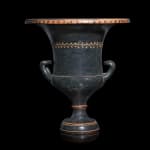Greek
An Attic black-glazed calyx krater, Circa 4th century BC
Pottery
Height: 48 cm
Of impressive size, flaring elegantly to the broad rim, the stem of the foot with raised collar, the body decorated with an ochre painted and gilt wreath, ovolo on the...
Of impressive size, flaring elegantly to the broad rim, the stem of the foot with raised collar, the body decorated with an ochre painted and gilt wreath, ovolo on the rim.
Provenance
Fatema Soudavar Farmanfarmaian (b. 1940) Collection, Geneva and London, acquired prior to 1998Literature
The calyx krater was a vessel used for mixing wine with water. Distinguished by the handles placed low on the body (the cul), the upwards, curved shape of the handles resembles the calyx of a flower, hence the name. This example represents the later style of the form, exemplifying the trends in the 4th century BC of vases becoming more elongated. For discussion of their uses in the symposium, see F. Lissarague, ‘Around the Krater: An Aspect of Banquet Imagery’ in O. Murray, Sympotica, Oxford, 1990.For another Attic calyx krater decorated with a very ornamental gilt wreath, see British Museum acc. no. 1871,0722.3; also the Metropolitan Museum of Art, New York, acc. no. 91.1.459: G.H. Kopcke, 'Schwarzfirniskeramik' in Mitteilungen des Deutschen Archäologischen Instituts, Römische Abteilung, 79, 1964, pp. 31 no. 36, 68.
1
of
17



